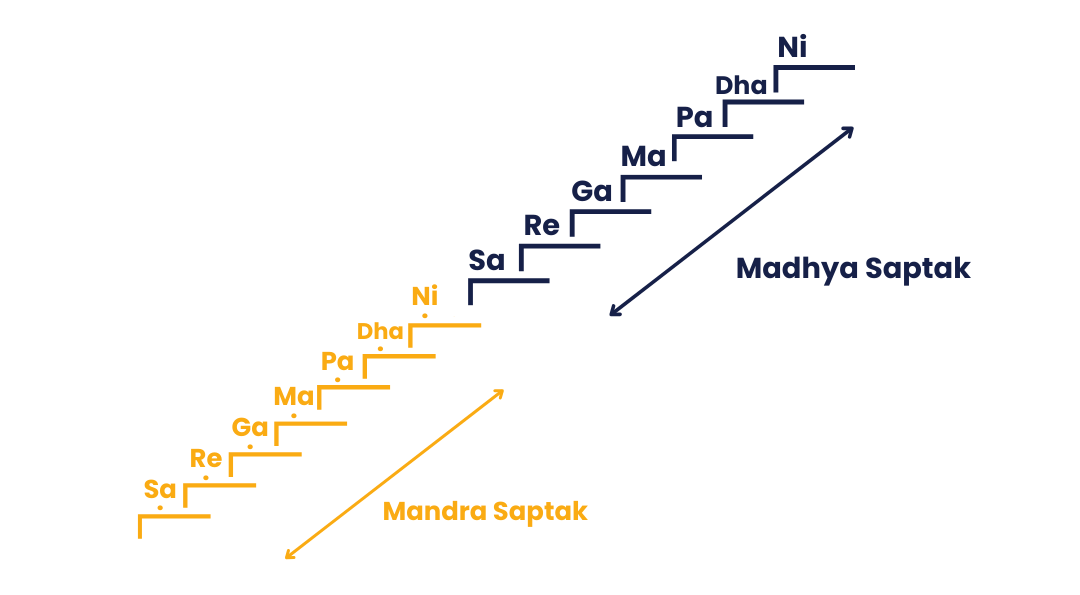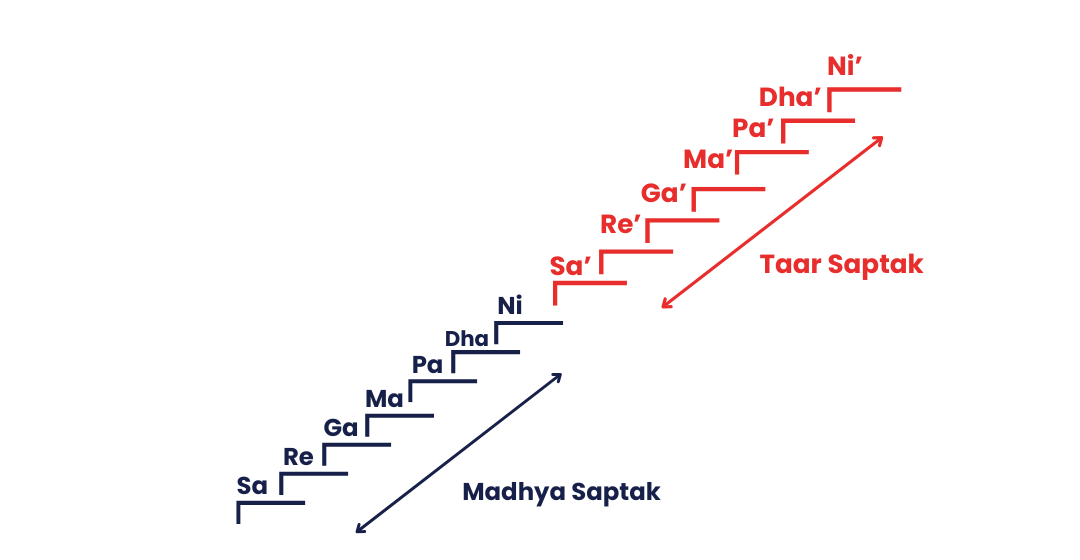
Table of Contents
Learning to sing begins with understanding swaras, just like reading or writing starts with learning the alphabet. Swaras form the foundation of Hindustani Classical Music and even popular Bollywood singing.
In this article, let’s understand the foundation of singing - swar.
1. What is Swar?
All the sound cannot be called swar. It means Sound that is stable, pleasing, and has the resonance to acquire the status of Note.
A swar is the fundamental building block of music, much like a letter in the alphabet. The term "Swar" means “Note,” which serves as the basis for all singing and vocal training.
The Sanskrit phrase "Swayam Rajate Iti Swaraha" highlights that not all sounds qualify as a swar. A sound becomes a swar when it is stable, pleasing, and resonates in a way that earns it the status of a musical note.
2. The Seven Swaras of Indian Classical Music
Indian Classical Music is built on a system of seven swaras, also known as shuddh swaras (pure notes). The first and most fundamental note is Sa, and all other notes are defined in relation to Sa.
Here are the seven shuddh swaras:
- Sa - Shadja
- Re - Rishabh
- Ga - Gandhar
- Ma - Madhyam
- Pa - Pancham
- Dha - Dhaivat
- Ni - Nishad
These seven swaras form the core of Indian music, providing a structured framework for melodies and vocal training.
Some Interesting Mythological Facts

There Are Multiple Theories Behind The Origin of Sa-Re-Ga-Ma-Pa-Da-Ni.
But the most common belief is that Sama Veda is the root of the origin of Indian notes.
Naradiya Shiksha (1.5.3; 1.5.4) verses mean that the swaras of Indian Classical Music were derived from various birds and animals.
Where Sa, Ma And Pa are sounds made by birds and Re, Ga, Dha And Ni are sounds made by animals.
3.Vikrit Swaras
Did you know how many swaras exist in Indian Classical Music?
While we are familiar with the 7 shuddh swaras (natural notes), some notes can also be sung either slightly higher or lower than their natural pitch. These are called Vikrit Swaras.
Vikrit Swaras are divided into two categories:
- Komal Swaras (Lowered Scale): These are also known as flat notes. Not all swaras can be lowered; only Re, Ga, Dha, and Ni can become komal. To represent a komal swar, we underline it, like this: Re, Ga, Dha, Ni
- Teevra Swara (Elevated Scale): This is also referred to as a sharp note. Only Ma is sung as teevra swar and is written as Ma' for clarity.
Understanding these variations adds depth and nuance to Indian Classical Music!
Sa and Pa do not have vikrit swaras, and hence, are also called as Achal Swar as they never change in the scale.
4. Saptak
A Saptak in Indian Classical Music consists of seven shuddh swaras (natural notes) and five vikrit swaras (altered notes). In Western music, a Saptak is equivalent to an octave.
The swaras in a Saptak are: Sa, Re, Re (komal), Ga, Ga (komal), Ma, Ma’ (teevra), Pa, Dha, Dha (komal), Ni, Ni (komal), and Sa’.
5. Vocal Range
A vocal range refers to the span of notes a person can sing, from the lowest to the highest. A trained human voice typically covers a range of three saptaks (octaves):
- Mandra Saptak – Lower Octave
- Madhya Saptak – Middle Octave
- Taar Saptak – Upper Octave
A. Madhya Saptak
The Madhya Saptak is the scale where singing and speaking feel the most natural and effortless.
- For female singers, the Madhya Sa is typically in scales like G# (Kali 4), A (Safed 6), or A# (Kali 5).
- For male singers, common scales for Madhya Sa include C# (Kali 1), D# (Kali 2), or E (Safed 3).
In Madhya Saptak, the swaras are written as Sa Re Ga Ma Pa Dha Ni.

B. Mandra Saptak
The Mandra Saptak includes the notes that descend below the Madhya Saptak Sa, starting from Madhya Sa down to Mandra Ni. In this range, a singer's voice typically becomes deeper and more resonant.
The practice of singing in the Mandra Saptak is known as Kharaj Sadhana, which helps develop voice control and depth. While it’s difficult for the human voice to reach the lowest note of Mandra Nishad (Ni), instrumentalists can go further down to Mandra Sa when playing certain ragas.
To indicate a note in the Mandra Saptak, a dot "." is placed below the swar as shown in the photo below.

C. Taar Saptak
The Taar Saptak comprises the notes that ascend above the Madhya Saptak Ni, taking the voice to its higher registers. Singing in the Taar Saptak requires precision, control, and practice to maintain clarity and avoid strain, as the voice becomes sharper and more delicate in this range.
Reaching and sustaining notes in the Taar Saptak is an important aspect of Indian Classical Music, as it showcases a singer’s ability to explore the higher octaves with grace and finesse.
To represent a note in the Taar Saptak, an apostrophe " ' " is placed above the swar (e.g., Sa' Re' Ga').

The natural vocal range of most humans allows them to sing comfortably from Mandra Saptak Pancham (Pa) to Taar Saptak Pancham (Pa), for both male and female singers. This range forms the foundation for exploring all three octaves in Indian Classical Music.
To help students practice swaras across the Mandra, Madhya, and Taar Saptaks, refer to the number line below, which illustrates the flow of notes through these octaves.

Understanding swaras and their placement in the three saptaks—Mandra, Madhya, and Taar—is essential for anyone beginning their journey in Hindustani Classical Music. These fundamental concepts form the building blocks of raga practice, voice training, and musical expression.
By mastering these swaras, students can expand their vocal range, refine their techniques, and explore the beauty and depth of Indian Classical Music.
Whether you are a singer or an instrumentalist, the world of swaras opens the door to endless possibilities in music. Keep practicing, and let your musical journey unfold!
~Written by:
Sudha Dhananjay Lachyan
Hindustani Classical Vocalist, SME